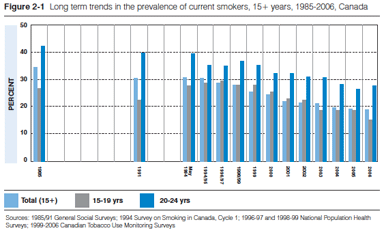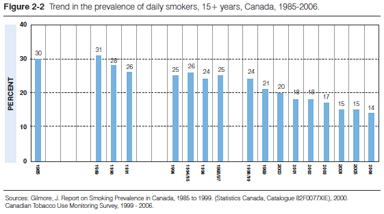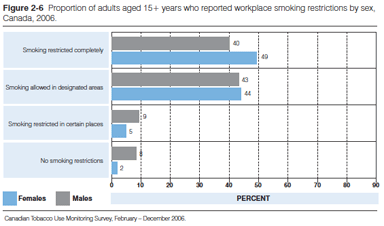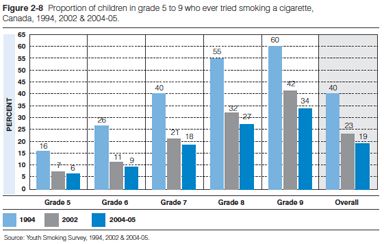Tobacco Use
Introduction
Tobacco use is the most important preventable risk factor for diseases of the lung. More than 13,400 adult deaths from lung cancer and 8,200 adult deaths from respiratory diseases are estimated to have resulted from smoking in 2002. An additional 33 deaths from sudden infant death syndrome (SIDS) arising during the perinatal period were also attributed to tobacco smoke. With its impact on lung disease, tobacco use continues to represent a considerable public health burden. Smoking-attributed mortality for chronic obstructive pulmonary disease (COPD) increased faster than for any other disease between 1989 and 2002, but lung cancer remains the leading cause of death due to smoking.1, 2
Exposure to tobacco smoke can be direct, by active smoking, or indirect, by exposure to second-hand smoke (SHS) or maternal smoking during pregnancy. In terms of lung disease, active smoking is causally linked to lung cancer, poor asthma control, acute respiratory illness, chronic obstructive pulmonary disease (COPD) and all major respiratory symptoms (coughing, phlegm, wheezing and dyspnea) among adults. In children and adolescents, active smoking is associated with respiratory symptoms (coughing, phlegm, wheezing and dyspnea) and asthma-related symptoms (e.g., wheezing).3 Passive smoking is associated with a number of acute respiratory effects affecting both the upper and lower respiratory tract. For instance, studies on adults exposed to SHS have demonstrated a causal association between SHS and eye and nasal irritations, whereas exposure in children is associated with acute lower respiratory tract infections (bronchitis or pneumonia), induction and exacerbation of asthma, chronic respiratory symptoms and middle ear infections. Exposure in utero is associated with reduced lung function in infants and SIDS.4
Smokers who quit smoking reduce their tobacco-related morbidity and mortality associated with lung disease. The improvements in health are dramatic and immediate. Oxygen levels in the blood increase to normal within hours as carbon monoxide levels drop. Lung capacity increases within days, and circulation improves within weeks. Risk of stroke and other circulatory diseases diminishes, and the chance of smoking-related heart attack is cut in half within a year. Within a few years, the chance that an ex-smoker will get cancer is reduced by half compared to those who continue to smoke, and within 15 years the risk of a fatal heart attack is almost the same as for a person who has never smoked.5
These facts make tobacco reduction strategies the cornerstone of any effort directed at preventing respiratory disease.
Prevalence
Smoking among Adults
According to the 2006 Canadian Tobacco Use Monitoring Survey (CTUMS),6 slightly fewer than 5 million people, representing 19% of the population aged 15 years and older, were current daily or non-daily smokers. This represents a decline in smoking prevalence from 35% in 1985 (Figure 2-1), and includes 4% of the Canadian population who reported smoking occasionally or on a non-daily basis. Among the Canadian population, slightly more males (20%) aged 15 years and older were current smokers in 2006 than females (17%).
The rate for First Nations adults on reserve (58.8%) is about triple the rate for Canadians in general.7 Forty-six percent report smoking daily and almost 13% smoking occasionally. The rate for non-reserve Aboriginal peoples is more than double the Canadian rate (36% report smoking daily and 8% smoke occasionally).8 Methods and response rates vary between the Canadian surveys of Aboriginal populations. Consequently, results may not be directly comparable to other Canadian surveys (non-Aboriginal and Aboriginal) and may not be generalizable to the Aboriginal people across Canada.
The 14% of Canadians who smoke daily (Figure 2-2) reported smoking on average 15.5 cigarettes per day, slightly less than the 15.7 cigarettes per day reported in 2005 (Figure 2-3). Men continued to smoke more cigarettes than women—16.9 cigarettes per day, compared with 13.8 for females. Current smokers among First Nations adults on reserve report smoking fewer cigarettes per day (10.5) than other Canadians.9
Smoking among Youth
The rate of smoking among youth aged 15-19 years of age was 15% (about 320,000 youths) in 2006 (Figure 2-1), with daily smokers reportedly consuming an average of 12.3 cigarettes per day. Nine percent of youths reported smoking daily (Figure 2-4), and 6% reported smoking occasionally. There was no statistically significant difference in the prevalence of smoking among teen girls (14%) and teen boys (16%). This was the lowest annual smoking rate for teen boys and girls since monitoring of smoking began in 1965.
Smoking among Young Adults
The prevalence of smoking among young adults 20-24 years of age was 27% (about 612,000 young adults) in 2006 (Figure 2-1). Within this age group, a greater proportion (30%) of males smoked than females (24%) (Figure 2-5); among daily smokers, males smoked an average of 3.1 more cigarettes daily (14.2) than their female counterparts (11.1). Young adults still display the highest smoking rates of any age group.
About 70% of First Nations young adults on reserve between 18 and 29 years of age are current smokers.10 Young adult men smoke more cigarettes daily (10.2) than women of the same age (7.7).
Exposure to Second-hand Smoke (SHS)
In 2006, 15% of Canadian households reported at least one person who smoked inside the home every day or almost every day. Of those households without someone regularly smoking inside the home, 86% did not allow smoking inside their home. Nine percent of children 0-11 years of age (about 355,000 children) were regularly exposed to second-hand smoke at home, a reduction from 26% (1.1 million children) in 1999.
Ninety-four percent of those who worked in the last 12 months reported some kind of smoking restriction in the workplace. Of this total, 44% reported that their workplace was completely smoke-free (compared to 40% of workers in 1994), while only 6% reported no restriction at all. A higher percentage of women than men reported that smoking was restricted in their workplace. Smoking was completely restricted in the workplace for 49% of women, compared to only 40% of men. Approximately 8% of men reported no restrictions in their workplace, compared to only 2% of women (Figure 2-6).
Prevalence of Maternal Smoking in Pregnancy
In 2006, 10% of women between the ages of 20 and 44 who had been pregnant in the previous five years reported smoking during their most recent pregnancy. Seven percent of women reporting a pregnancy in the last five years stated that their spouse smoked regularly. Lower education was associated with higher prevalence of smoking during pregnancy (Figure 2-7).
Health Care Services/Hospitalizations
More than 2.2 million acute care hospital days were attributed to tobacco in 2002, accounting for slightly more than 10% of the total.11 This estimate includes 46,700 days attributed to exposure to passive smoking. Men used 61% of these days (1,359,159 days, compared to 850,996 for women). The use of acute care hospital days rose with age: over two-thirds of the days (1,510,932) were used by Canadians 60 years and older.
Health Outcomes
In 2002, tobacco smoking was responsible for 750 deaths from pneumonia/influenza and 7,533 deaths from COPD.12 Slightly more men than women died of smoking-related respiratory illnesses (55% of pneumonia/influenza deaths and 58% of COPD deaths were attributable to smoking). Almost 70% of tobacco-attributable deaths from pneumonia/ influenza occurred in Canadians 80 years of age or older.
The estimated 37,209 tobacco-attributable deaths in Canada in 2002 accounted for 16.6% of all Canadian deaths.13 Cigarette smoking continues to be the primary risk factor for three of the most common causes of death in Canada (lung cancer, ischemic heart disease and respiratory diseases). These three causes accounted for more than two-thirds of all smoking related deaths. Active tobacco smoking resulted in the deaths of 23,259 men; of these, 9,028 were due to lung cancer and 4,788 to respiratory diseases. There were 13,119 smoking-related deaths among women, with 4,373 deaths from lung cancer and 3,494 from respiratory diseases. Tobacco smoking also accounted for 92 infant deaths from conditions (low birth weight, short gestation and sudden infant death syndrome) arising during the perinatal period.
It is estimated that passive smoking resulted in 252 lung cancer deaths in non-smokers aged 15 years and older (157 males and 95 females) in 2002.
The trends in smoking-attributed mortality, with more males than females dying of tobacco-related causes, reflect smoking behaviour two to three decades ago. Although the prevalence of smoking continues to decline, the Canadian population dynamics (age structure and population growth) account for the increase in the number of deaths from lung cancer and chronic obstructive pulmonary disease.
Economic Costs
In 2002, tobacco use accounted for $17 billion in costs to Canadians.14 The largest part ($12.5 billion) was in indirect costs for lost productivity due to illness and premature death, including $10.5 billion for long-term disability due to tobacco use. The direct costs attributed to tobacco use were estimated to be $4.4 billion. The bulk of this was $2.5 billion for acute care hospitalizations and $1.4 billion for prescription drugs. The cost of acute care hospitalization translates to over 2.2 million days in hospital due to tobacco, including 46,700 days attributed to exposure to SHS. Direct costs for prevention and research and fire damage were also included in these estimates. A number of smoking-attributable costs were not included because there was no way to estimate their value. These costs included visits of friends and families to sick and dying smokers, and smoking-attributable home health care. In addition, the psychological and emotional costs incurred by the families of dead or dying smokers are incalculable.
These figures show a steady increase in smoking-attributable costs in Canada since 1966 ($2.0 billion in 1991$).15
Discussion and Implications
Comprehensive, integrated and sustained actions are universally recognized to be key to successful tobacco control strategies. The Federal Tobacco Control Strategy (FTCS), launched by the Government of Canada in April 2001, is one such approach. This Strategy, carried out in close collaboration with partners, is directed at Canadians of all ages. Four mutually reinforcing components have been identified to support achievement of the Strategy’s objectives: protection, prevention, cessation, and harm reduction/product modification.
Progress continues to be measured in many areas of tobacco control. Since 2003, smoking among youth aged 15-19 years dropped to a level lower than that of the general population. In 2006, an estimated 15% of youths smoked, versus 19% of Canadians in general. According to the 2004-05 Youth Smoking Survey, 21% of youths in grades 5 to 9 reported ever trying a cigarette, compared to 40% in 1994 (Figure 2-1).16 The prevalence of current smoking among these students dropped from 7% in 1994 to 2% in 2004-05.
Public opinion in favour of smoking restrictions in public places has also been growing. In 2006, more than two-thirds (69%) of Canadians who expressed their opinion felt that smoking should not be allowed anywhere in restaurants.17 This is up from 42% in 2001. When examined by smoking status, this opinion was held by 50% of current smokers and 73% of non-smokers. Although those in favour of smoke-free bars and taverns still constitute a minority, their ranks also grew from 26% in 2001 to 49% in 2006. Only 24% of current smokers were of this opinion, compared to 54% of non-smokers.
Most Canadian households voluntarily ban or restrict smoking in their homes. These restrictions have reduced the proportion and number of children exposed to passive smoke in the home. Parental or caregiver smoking not only affects the health of the children, but also sends the message that smoking is an acceptable adult behaviour. Continued efforts are needed so that parents and other family members understand the importance of maintaining a smoke-free environment. In 2006, 25% of Canadians 15 years of age and older reported being exposed to second-hand smoke inside a car or other vehicle in the past month.18 At the 2007 Canadian Medical Association annual meeting, a resolution was proposed which “urges all levels of government to implement a Canada-wide ban on smoking in vehicles carrying children”.19
Progress has also been noted in reported workplace restrictions. In 2006, 40% of respondents felt that smoking should not be allowed anywhere in the workplace, indoors or out. This opinion was expressed by 19% of current smokers and 44% of non-smokers. Less than half (46%) of all respondents—including 57% of current smokers and 44% of non-smokers—felt that smoking should be allowed only in designated outdoor areas. In addition to the increase in the prevalence of smoke-free and smoke-restricted workplaces, many provincial and territorial governments have enacted legislation requiring public places to be smoke-free: Northwest Territories, Nunavut, New Brunswick and Manitoba in 2004; Saskatchewan and Newfoundland and Labrador in 2005; Ontario, Quebec and Nova Scotia in 2006.
Nonetheless, Canadian smoking rates remain high among subpopulations, including young adults 20 to 24 years and Aboriginal people. As a result, smoking will continue to cause major health problems. While smoking rates have dropped significantly, the measured health outcomes (morbidity and mortality) have not yet shown the same trends.
1 Kaiserman MJ., Makomaski Illing EM. Mortality attributable to tobacco use in Canada and its regions, 1998. Can J Public Health 2004; 95:1:38-44.
2 Rehm, J. et al. The costs of substance abuse in Canada 2002. Ottawa: Canadian Centre on Substance Abuse; 2006.
3 U.S. Department of Health and Human Services. The Health Consequences of Smoking: A report of the Surgeon General. Bethesda, MD: U.S. Department of Health and Human Services, Centers for Disease Control and Prevention, National Center for Chronic Disease Prevention and Health Promotion, Office on Smoking and Health; 2004.
4 National Cancer Institute. Health effects of exposure to environmental tobacco smoke: the report of the California Environmental Protection Agency. Smoking and Tobacco Control Monograph no. 10. Bethesda, MD. U.S. Department of Health and Human Services, National Institutes of Health, HIH Pub. No. 99-4545; 1999.
5 Health Canada. Healthy living: Rewards of quitting. Ottawa: Health Canada; n.d. [updated 2005 May 1]. Available from:
http://www.hc-sc.gc.ca/hl-vs/tobac-tabac/quit-cesser/ready-pret/reward-gratifiant/index_e.html
6 Health Canada. Canadian Tobacco Use Monitoring Survey (2006). Ottawa: Health Canada; n.d. Available from:
http://www.hc-sc.gc.ca/hl-vs/tobac-tabac/research-recherche/stat/ctums-esutc/2006/index_e.html
7 First Nations Centre. First Nations regional longitudinal health survey (RHS) 2002/03. Ottawa: The Centre, 2005.
Available from http://rhs-ers.ca/english/pdf/rhs2002-03reports/rhs2002-03-technicalreport-afn.pdf
8 Statistics Canada. Aboriginal Peoples Survey 2001
15 Kaiserman MJ, The Cost of Smoking in Canada, 1991. Chronic Diseases in Canada. 1997;18:1.
16 Health Canada. 2004-05 Youth Smoking Survey. Available from:
http://www.hc-sc.gc.ca/hl-vs/tobac-tabac/research-recherche/stat/survey-sondage/2004-2005/index_e.html
17 Health Canada. Canadian Tobacco Use Monitoring Survey (2006).
18 Health Canada. Canadian Tobacco Use Monitoring Survey (2006).
19 Canadian Medical Association. CMA annual meeting resolutions (unconfirmed). Item 91. August 2007. http://www.cma.ca/index.cfm/ci_id/53612/la_id/1.htm








